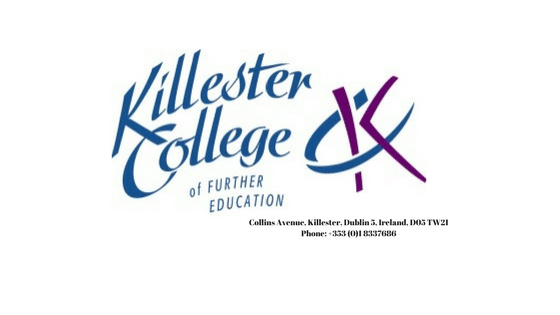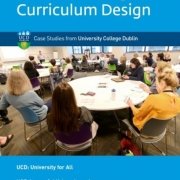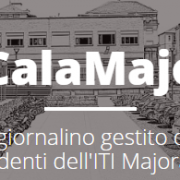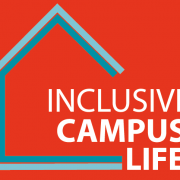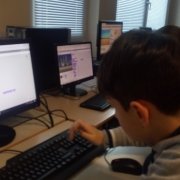Inclusive Vocational Education in Dublin
Excerpt
Killester College of Further Education offers formal and non-formal education, mostly post-secondary vocational training opportunities to anybody over 16, the end of compulsory schooling age in Ireland. Their services are available regardless previous academic achievement – documented or not - or special education needs.
Narrative, origins and objectives of the initiative
What kind of project is this? Please give a short description (summary) of it.
Killester College of Further Education is part of the Dublin Board of Education, and offers education services for students of all ages above secondary schooling age. They have been working as an inclusive college since 2002, meaning that they can support the learning of people with any special education need (due to disability, learning difficulties, behavioural problems, lack of English skills, etc.). For most of them they provide education services within regular classroom conditions. Their work is based on a recognition of a prior learning model that makes it possible to offer further education to those who could not finish their formal secondary education, or have no documentation as proof. The main goal of the college is to prepare students for lifelong employ-ability instead of aiming at lifelong employment, thus they have a very flexible and holistic approach to education.
Please tell us why, in general, this project is considered a successful one?
The programme has been running since 2002 and the college is able to support the learning of an increasing diverse community of learners, and for an increasing percentage of them the learning happens in a regular classroom environment. They also consider it a success that they have implemented special methodologies for the validation and certification of learning based on specific needs that the labour market accepts. Their work has won them an award for excellence by accessibility.
And why would you consider it a grass-roots initiative?
The special programme was an initiative of the school head, it grew out of an OECD project on the recognition of prior learning.
What challenges needed to be solved in this project?
The main challenge was to train and support teachers in a way that makes individual learning provisions part of their daily work, having experience of and a willingness to deal with various special needs. Fundraising was therefore inevitable as the first few years were very costly with the training as well as IT investment needs. It helped to answer the challenge of training teaching staff in the fields of teaching and assessment.
Is this initiative based on any particular theoretical framework? Which one?
The basis of the programme is the model developed in an OECD project on the recognition of prior learning. This led to the college implementing an open access and an inclusive individual approach.
(Appendix) Is your intervention standing on its own or is it a part of a bigger and more holistic approach?
The college works in collaboration with local communities, especially in working with those having low English skill levels, disability organisations, employers, business developers and also other schools in the Dublin area. Inclusion in education is national policy in Ireland and the implementation happens through collaboration.
Please describe the group(s) intended as beneficiaries of this initiative
Why has this group (have these groups) been chosen?
When the programme started, the school had already been an open one, offering space for the operations of disability organisations and making the building accessible for disabled people. At the beginning most of their special needs students were wheelchair users. Currently they do not really have a specific target group, they welcome people with any kind of special education need or no special needs at all.
Could you please tell us something about the relative size of the (of each) target group, within the school/university population, region and/or country?
The college offers education to about 450-500 students per year. They come from the Dublin area. The organisation could not provide statistics for the different target groups. Disability statistics in the country are based on self-declaration and statistics for other special education needs are not available and there are also only estimations on the migrant target group. They report that they can generally offer supply for the local demand.
Which social characteristics are taken into account and what is the geographical area covered?
The geographic area covered is Dublin. Social characteristics show a great diversity for their different target groups. Disabled people often have accessibility issues, special needs students often have a history of education failure and/or behavioural problems, and migrant students often lack language skills and also often carry trauma.
On which level is the project implemented?
School level
Please describe the political and socio-economic factors that you believe have been important enablers for your initiative
Did the initiative have political support?
As inclusion is national policy in Ireland, the initiative has had political support. In the early 2000s, when the programme started, the Irish economy was booming, and more funding was available for education and experimenting in education. During the global economic crisis the political support was still there, but only on the level of rhetorics. Funding was cut severely, which luckily did not endanger the programme too much.
How did it fit with local, regional or national policies?
Apart from inclusive education being the basis of education policy in Ireland, the programme is fine-tuned, especially in the specific training offered, in collaboration with local employers and business developers as well as municipalities.
Who are the stakeholders supporting the initiative?
Committed school leadership and the college’s well-trained and committed teaching staff are key to the success of the programme. As compulsory work placement is part of their training programmes, businesses are also important stakeholders. Schools in the Dublin region are also stakeholders, and so are local municipalities and NGOs.
Are there particular demographic changes present that are influencing the project?
The only significant demographic change since the programme started is that, in the early 2000s, the majority of migrants came with high qualifications. Nowadays, there are more low-qualified new arrivals and/or children of earlier migrants. It is more an environmental or opportunity change that there is a growing uncertainty at the labour market, so students need to become more flexible than before. This uncertainty also leads to more adult students applying for re-training, new qualifications, many of them towards the end of their working life. This demographic challenge needed to be addressed by the school.
What is the institutional strategy and culture of the (educational) organization?
Their institutional strategy is based on an inclusive individualised approach to their students. Each student is assessed for their existing skills and competences at enrollment, institutional requirements towards the individual student are not based on formal qualifications/diplomas. Their strategy is to make provisions for special education needs part of regular teaching practices. They consider themselves an inclusive institution since 2/3 of students who declare at application they need learning support, are offered this support through their normal methodology.
To what extent does the initiative have an influence on institutional policy (or potential influence) of the (educational) organization?
The programme had a fundamentally changed institutional policy from offering regular, traditional training to individualised learning programmes. They also switched emphasis towards traditionally peripheral subjects, such as communication or personal development, as they are considered the foundation for success. As a result of the programme, it is part of institutional culture to support each individual student and do extra work.
(Appendix) Is there public support for your initiative and the issue it addresses?
The Irish economy has experienced highs and lows in the last couple of decades. The end of the ‘Irish miracle’, the economic crisis and unemployment growing as a result of it, have definitely highlighted initiatives that help employability. Inclusion in education also has public support in the country.
(Appendix) What other factors do you think have been important for the success of this initiative?
Nothing else in particular.
Please describe the overall initiative design and the methods and tools used to reach the goals
Please describe the specific activities carried out.
The design and implementation of the programme started with the introduction of a recognition of a prior learning model. A universal design was implemented to offer a truly inclusive approach. For this there was a need for teacher training and the whole teaching staff had to be re-trained. Today they have a training and peer support methodology in place to support new staff in blending in with the school. However, they have a low turnover of teaching staff and thus a fairly permanent team.
When a student applies for the school, they have to indicate the vocation and level they are aiming for. The college has a course coordinator who interviews the prospective student to evaluate their competence and determine if the course they applied for is not too difficult or too easy for them. In the vocational training itself they implement a flexible and highly professional approach, using IT extensively, including Moodle modules. About 120 students require special learning support, and they can provide the necessary support to 2/3 of them within the regular classroom context. For supporting the rest of the students they have specialised supporting staff. They also implement an inclusive assessment methodology. This is supported by the fact that the Irish certification system is designed to be accessible for disabled candidates.
In the framework of their training, they put emphasis on subjects that support the general personal development of students by introducing subjects like communication, personal development and career planning. Compulsory work placement is also part of the programme, enabling students not only to gain work experience, but also to change track if the chosen vocation does not fully agree with the given student.
What were the key roles (teacher, student, management team etc.) within the project?
School leadership: providing the framework, resources and training with full commitment to the programme
Teachers: personal professional development and collaboration for best implementation
Students: making personal choices and participating in the training with personal commitment
Business partners: offering work placement and subsequent employment
What ideas, tools, theories, models, methodology (etc.) have been used to reach the goals?
Recognition of prior learning model
Inclusive individualised teaching methodologies
Accessible, inclusive assessment methods
What are the final revenues of the project?
A significant increase of employability and employment of people with special education needs, people towards the end of their careers who need re-training are the explicit outcomes. Their highly motivated and well-trained staff, implementing a universal design, have better professional results and better personal achievements.
Please describe if your project ensured its sustainability
If so, how did you ensure the short-term impact of the project?
By offering the highest level of professional performance and by supporting students to choose the vocational pathways most suitable for them.
And how did you ensure the long-term impact of the project?
For long-term impact the school cooperates with local communities, NGOs, employers, and business developers. At the same time a long-term impact is also ensured by the general approach of their training aiming at long-term employability rather than employment per se.
Has your project been replicated elsewhere?
Not that they are aware of.
Please tell us about the resources used in this initiative
What was the budget for the initiative?
The programme is within the regular budgetary framework of the school, so it is not possible to define a budget. Ireland offers activity-based funding for education, focusing on inclusion. It is part of the school head’s autonomy to design and implement their local budget, given this funding. However, the school has had some projects during introductory years for training.
How much did the initiative depend on volunteers?
It does not make use of volunteers.
How were the costs perceived by the public/the sector/other stakeholders?
As the programme has no special budget, this question is difficult to answer. However, funding has been ensured for a school with such a special programme, so it can be assumed that it has been considered worthwhile.
To what extent did the initiative achieve its objectives?
Please describe the evidence to support the success of your initiative.
Successful completion of post-secondary education by people without formal certification from their general schooling.
A high percentage of students that have learning difficulties and/or disabilities obtaining formal degrees.
The school implements a progression survey for former students 6, 12 and 24 months after completion to monitor success.
Did the intervention lead to any unintended (positive) outcomes?
The teachers implementing an individual inclusive approach have a major impact on all students, not just the ones with special education support needs. There has been a significant decrease of failing and an increase of outstanding achievement in the general student population of the school.
What indicators (quantitative and qualitative) have you measured to demonstrate success?
- completion rates
- employment statistics
- outstanding performance statistics
(Appendix) How did you evaluate/monitor this intervention?
The college implements individualised inclusive formative assessment during the training, accessible certification methodology and also follow up the personal progress of students. A tracking system is being introduced in the country.

